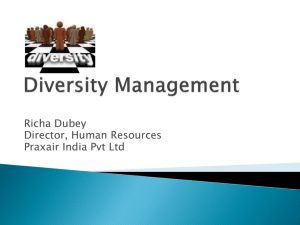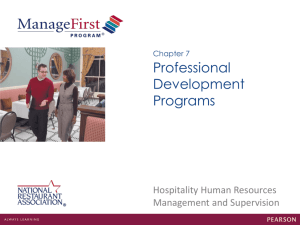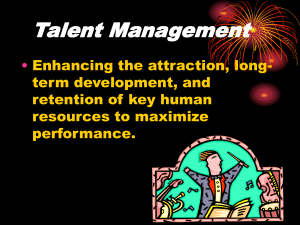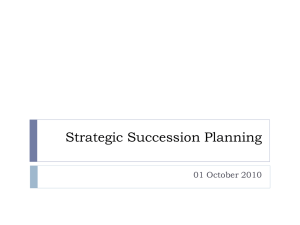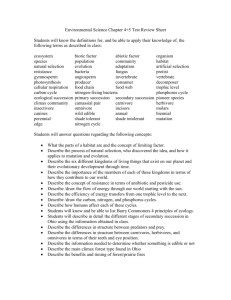Workforce Development
advertisement
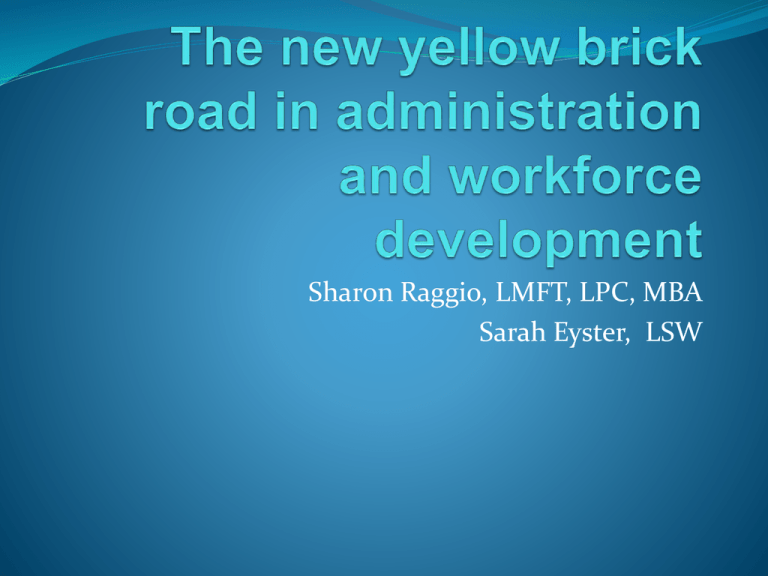
Sharon Raggio, LMFT, LPC, MBA Sarah Eyster, LSW GOALS Learn how to link succession planning with your organization’s strategic plan Learn 5 best practices for succession planning Learn a mentorship model that is easily implemented TRUE STORY Sharon Raggio became new CEO of Colorado West Regional Mental Health, Inc in March of 2008 Within first month, realized organization was on verge of bankruptcy due to $10m debt and psychiatric hospital was almost closed twice When asked senior leaders about this, answer was some version of “not my job” or “I said something but it did not get attention” or “I did not know the extent” Total Compensation Framework Business Strategy & Desired Culture Human Capital Strategy Total Compensation Philosophy/Employee Value Proposition Attract & Retain Motivate & Reward Base BaseSalary Pay Benefits Premium Career Paths Pay Variable Incentives Pay Recognition Stock Recognition Build Capability Talent CareerReview Paths Work Environment Tech. Training Communications Prof. Development Team Effectiveness Performance Management Cost of Doing Business Engage Investment in Performance BASIC BELIEFS You need to identify and understand the developmental needs of your employees. You must ensure that all key employees understand their career paths and the roles they are being developed to fill. You need to focus resources on key employee retention. You need to be aware of employment trends in your area to know the roles you will have a difficult time filling externally. WHY IS SUCCESSION PLANNING IMPORTANT? While the demand for effective managers continues to grow, the retirement of baby boomers is producing a sharp decline in the ranks of available personnel. In addition, the executives of the future are expected to be more sophisticated in order to develop and lead new global and technological initiatives. For these reasons, careful planning for the eventual replacement of managers at all levels in organizations has gained strategic importance. WHY The average college graduate will change jobs five times in his or her career. Within the next decade, this norm will probably increase to seven job changes. Recruiting and retaining leaders becomes an economic and strategic challenge. WHY The forces that have renewed interest in succession systems and have changed them in dramatic ways are trends that have affected business in the new global economy. Leadership is and has always been a relatively scarce commodity within companies. To lose a strong, effective leader is a serious blow to any organization. Companies reward high performers with opportunities for development and not necessarily extended, long-term employment. The internet has enhanced the mobility of leadership talent, making it easy for employees to find opportunities elsewhere and for those opportunities to come knocking on their door. Executive recruiters and headhunters today possess greater clout and sophistication. No longer is it unfair game to recruit your competitor’s best and brightest workers. Non-stop, unpredictable organizational change has caused organizations to quickly identify growing gaps in talent and emerging needs for new types of talent. SUCCESSION PLANNING The real key in succession management is to create a match between the organization's future needs and the aspirations of individuals. The only way to keep talented people is to provide them with growth opportunities that keep them stretching and finding more promising opportunities they might find elsewhere. WHAT IS SUCCESSION MANAGEMENT? Succession management serves as an interface between the human resource function and the strategic direction of an organization. In this role, it is a vital resource in anticipating the future needs of the organization and helps find, assess, develop, and monitor the human capital required by the organization's strategy. WHAT IS SUCCESSION MANAGEMENT Succession management identifies and monitors various talent pools within the organization to match the future needs of the organization with the bench strength of available talent. Not having the right talent in place is often a growthlimiting factor in achieving business potential. WHAT IS SUCCESSION PLANNING? Succession planning is not “replacement planning,” rather it is a primary driver of ongoing stewardship for an organization. Succession planning should be a constant initiative with periodic, formal check-ins. There are multiple dimensions to development, with emphasis on building experiences and competencies necessary to step into broader roles. Employee performance and employee potential are often confused and should be assessed independently. Succession planning must be integrated with executive development and staffing. Succession planning is a key process for mitigating talent risk and should be owned by senior management. BEST PRACTICES succession management is a continuous annual process enthusiastic support of the top management effective succession management is a journey, not a destination. The best-practice partners in many studies did not succeed in their first efforts at succession management 5 BEST PRACTICE STEPS Understand the business strategy of the organization and its staffing implications. Develop a process Assess talent Engage future leaders Measure-monitor and assess progress UNDERSTAND THE BUSINESS STRATEGY OF THE ORGANIZATION AND ITS STAFFING IMPLICATIONS Do you have a strategic plan? Do you link personnel skills and talent to the strategic plan? Do you determine what roles and skills are critical for the growth of the company Do you have job descriptions that are measurable and objective and link to the strategic plan? Do you have a succession management plan? DEVELOP A PROCESS Best-practice organizations make succession planning an integral corporate process by exhibiting a link between succession planning and overall business strategy. This link gives succession planning the opportunity to affect the corporation's long-term goals and objectives. Human resources is typically responsible for the tools and processes associated with successful succession planning. Business or line units are generally responsible for the "deliverables" -i.e., they use the system to manage their own staffing needs. Together, these two groups produce a comprehensive process. Technology plays an essential role in the succession planning process. Ideally, technology serves to facilitate the process (make it shorter, simpler, or more flexible) rather than becoming the focus of the process or inhibiting it in any way. Best-practiceASSESSMENT calls for use of a core set of TALENT competencies or behaviors to establish a standard of comparison for assessment. Most organizations use a subset of leadership competencies that are aligned with the core set. All use these competencies as a basis for performance management and four out five use these for identification of high- potential employees. Furthermore, best-practice organizations used fewer competencies, feeling that simplicity and focus were stronger advantages than comprehensive efforts. ENGAGE FUTURE LEADERS Best-practice organizations emphasize the importance of specific, individualized development plans for each employee. Individual development plans identify which developmental activities are needed, and the "best practice" firms typically have a mechanism in place to make it simple for the employee to conduct the developmental activities. Typically, human resource leaders will monitor employee follow-up in developmental activities. Best-practice partners rely on the fundamental developmental activities of coaching, training, and development most frequently and utilize all developmental activities to a much greater extent than the non best practice organizations. In addition to traditional executive education programs, bestpractice partners increasingly use special assignments, action learning, and web-based development activities. Best-practice organizations employ a wide range of DEVELOPMENTAL ACTIVITIES developmental activities to engage leaders and extend their capabilities. These firms spend considerable time creating stretch developmental opportunities that are consistent with the organization's needs, as well as with those of the individual. Goals are set annually. Several firms reported that they would give people a temporary assignment as a part of, or tied in with, an action learning assignment. Other offerings include mentoring, coaching, along with “university” type leadership programs. Dow's internal research indicates that graduates of their internal executive education program showed improvements in strategic thinking, external focus customer orientation, and global view. Dow also offers an extensive array of training courses on-line. GOALS AND STRETCH GOALS Does your organization set goals? Does your organization set stretch goals? Goals that you may not meet and really “stretch your abilities”? Typically these require new skills and risks and often involve using influential authority as opposed to positional authority TEMPORARY ASSIGNMENTS Does your organization provide “temporary assignments”? Work on a specific project Solve a specific problem Typically these require new skills and risks and often involve using influential authority as opposed to positional authority Organizational University Does your organization offer a “university”? Typically 4-8 days didactic (may be spread out) coupled with a project Learn about financials, “money making model” key performance indicators, compliance, leadership, PDSA cycles, etc… Typically a cross section of staff Focus on leadership development Followed by coaching/mentoring COACHING/MENTORING Organizations are only as successful as the men and women who make them work. So, if we care about our organizations and our people, we have to share our knowledge of the organizational culture; we have to share our wisdom; we have to mentor. COACHING/MENTORING Consider the sustaining power that often comes with having a business coach. Breathe into that for a few minutes. Really. Take a deep breath. Think about a change you would like to make in your career. What would it be like to have a coach/mentor on your path to serve as a guide? Where do you begin to find such as person? COACHING/MENTORING Start by understanding what coaching/mentoring is. There are as many definitions of coaching/mentoring as there are types of coaches/mentors. In business, some of common elements used to define coaching/mentoring are: One-on-one relationship between the person and the coach Specific goal(s) for change are set and usually focus on performance or personal development of an individual, often for the good of the organization. Process or methodology to identify needed changes, create self awareness, and practice new behaviors. Mode of sustaining the changes after the coaching relationship ends. COACHING/MENTORING A skillful coach/mentor guides the person by: Exploring what their current way of being/doing allows for and what it closes down. Defining new competencies needed for the desired changes. Identifying the new "muscles" needed to develop in the competency. Designing developmental exercises to practice and build the new muscles. Sharon and Sarah’s Mentoring Experience MEASURE Best-practice organizations use some variety of a box matrix for classifying the performance of their managers. In most instances, this matrix assesses individuals on the basis of performance, corporate values, and perceived potential. An individual who is performing well may not be judged as highly as someone who has not gotten comparable results but has persevered in a real stretch assignment. A popular competency was "learning agility." This refers to the ability and willingness to learn new material and adapt to new situations. MEASURE The major metric by which succession systems are evaluated is the percentage of openings filled from within the firm. DISCUSSION
